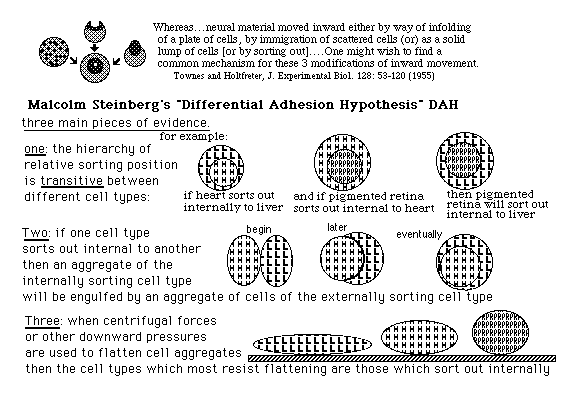April 16, 2007
Embryology Biology 441 Spring 2007 Albert Harris
Asexual Development by Budding, and Sorting Out of Dissociated Cells
What these phenomena have in common with each other is that bodies or parts of bodies can sometimes be formed in different ways than by embryonic development of an egg.*******************************************************************
Will NOT consider development of unfertilized oocytes, as occurs in production of male ants & bees, etc. and many other insects, and in some species of fish and lizards.
Development of unfertilized eggs IS asexual, but is accomplished by gastrulation, neurulation, germ layers etc. almost exactly as in normal embryonic development.
Sometimes results are haploid; but in many cases they become diploid by resorbing second polar body.
*******************************************************************
Development of buds of somatic tissues into whole new animals
Occurs in sponges, hydra,
many other Cnideria, like corals
Planaria,
and many invertebrate phyla that live as colonies, like Bryozoa
All of these can develop either from fertilized eggs, or from buds of tissues within which cells rearrange (and sometimes differentiate to form all the cells of their bodies)
Including colonial sea squirts.
(note, however, than half or more species of sea squirts are NOT colonial,
and develop only from fertilized eggs.
Budding of colonial sea squirts:
Transfer of many differentiated cells,
through blood vessels, and/or by active cell crawling.
New individuals produced by budding
Produce eggs and sperm, and also more asexual buds.
John Allen, who recently earned his PhD in this department, observed that then ends of arms of sea urchin plutei sometimes bud off to form new blastula stage embryos, which can themselves develop into plutei.
"Sorting out" of dissociated and randomly inter-mixed cells.
In some species of colonial sea squirts
(and also sponges, hydra and other cnideria,
and larval sea urchins)
As H.V.Wilson was the first to discover (in sponges)
and later in corals,
randomly mixed cells can rearrange to form
normally-functioning individual sponges, etc.
***********************************************
Dissociated amphibian embryo cells sort out by germ layer, and by subdivision of germ layers, but canŐt form frog or salamander bodies, just tissues and some organs, in abnormal geometrical patterns.
These phenomena were discovered and described in many research
papers by Johannes Holtfreter.
(especially a long paper by Townes & Holtfreter in J. Experimental Zoology
about 1955, in which the results of all possible germ layer combinations are described)
In the 1950s, Moscona and Trinkaus (separately) proved that embryonic mouse and chicken tissues can be dissociated [nto random mixtures of cells, and then sort out by differentiated cell type (but canŐt re-form functional animals, but only tissues and organs)
This led to the discovery of selective cell-cell adhesion proteins, including N-CAM "Neural Cell Adhesion Molecule) and several kinds of Cadherins. ("Cadherin E, Cadherin P, many others)
*********************************************************
Debates whether sorting out of dissociated cells is because of qualitative differences (in kind of adhesion molecules) or because of quantitative differences (in amount of adhesion)
Steinberg's "Differential Adhesion Hypothesis" << minimization of free energy of adhesion >>
evidence: transitive hierarchy of internal versus external position of sorting out
Alternative hypothetical explanations by Harris (1976) and Brodland (2005) " differential cell surface contraction hypothesis"
